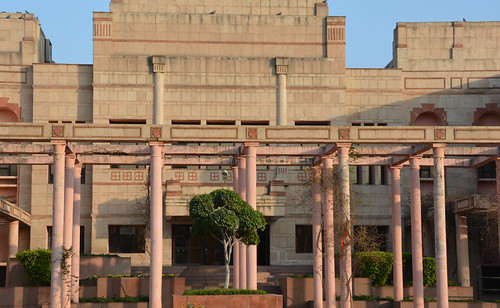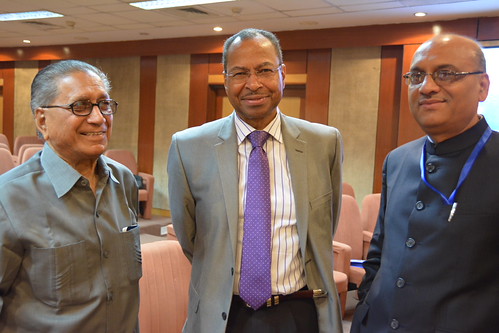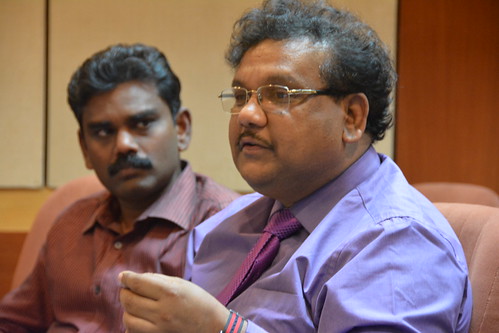
At the lobby of National Agricultural Science Centre (photo credit: ILRI/Susan MacMillan).
Note: This is the tenth in a series of articles on
‘Curds and goats, lives and livelihoods—
A dozen stories from northern and eastern India’.
PART 10: ‘Leveling’ access to livestock information:
Knowledge management talks at an ICAR–ILRI communications workshop
By Jules Mateo and Susan MacMillan,
of the International Livestock Research Institute (ILRI)
This is the third of three reports on a Mar 2016 ICAR–ILRI communications workshop
held at ICAR’s New Delhi research complex.
To share best practices and explore opportunities for collaboration, the International Livestock Research Institute (ILRI) and the Indian Council of Agricultural Research (ICAR) held a joint communications and knowledge management workshop on 4 Mar 2016 at the National Agricultural Science Centre Complex in New Delhi, India.
The one-day communications workshop was held at the National Agricultural Science Centre Complex in New Delhi, India (photo credit: ILRI/Susan MacMillan).
The one-day workshop was co-organized by ILRI’s Communications and Knowledge Management (CKM) team and ICAR’s Directorate of Knowledge Management in Agriculture (DKMA). The workshop brought together 75 officials, scientists and communications experts from both organizations.
Officials and scientists from ILRI and ICAR attended the workshop (photo credit: ILRI/Susan MacMillan).
The workshop was organized around three focus areas: (1) creating impact through communicating research outputs, (2) communicating evidence for wider influence and (3) publishing and accessing research outputs and knowledge.
Workshop focus area 3: Accessing, publishing and disseminating research knowledge, information, data, products and outputs for wide accessibility and use
Focus area 3, the last session of the day, was divided into six 10-minute case studies on data and knowledge management and information dissemination from scientists and communications specialists from ILRI and ICAR, as well as a journalist covering science news in mass media. They shared experiences on how they access, manage and make agricultural information available online and on mobile phones.
Peter Ballantyne, head of ILRI Communications and Knowledge Management, presented on open-access approach to livestock information (photo credit: ILRI/Susan MacMillan).
The first case study, on open access/open publishing at ILRI, was presented by Peter Ballantyne, head of ILRI Communications and Knowledge Management. Ballantyne listed the many ways that ILRI is ‘working in the open’. These include open projects, open platforms, open conversations on social media, open (Google) books, open online (DSpace) repositories (CGSpace), open source (Github), open data (portals and datasets), open news, open to re-use (Creative Commons licence) and open for feedback. ILRI’s open-access policy, with 95% of its content open to the public, aims to increase the uptake of research products, make outputs widely available and accessible, generate (borderless) international public goods, and enhance communication and collaboration with the institute’ many partners.
Participants in a group discussion that followed found the principles and practices of open-access policy attractive but mentioned that ICAR would have to also consider the trade-offs of implementing such policies. ICAR now gets some revenue from selling many of its books, journals, magazines, manuals and other materials, albeit at low prices (the government subsidizes this publishing). A completely open-access policy would run counter to their business model. The participants recommended that ICAR find a balance between its open access and commercial interests.
Data management expert Dinesh Kumar (right) of ICAR’s Indian Agricultural Statistics Research Institute (photo credit: ILRI/Susan MacMillan).
Dinesh Kumar, from ICAR’s Indian Agricultural Statistics Research Institute (IASRI), discussed data management at IASRI, particularly the handling of genomic data. Kumar said his team’s goal is to manage massive and complex data in ways that make that data easier and faster to access online.
His team has been working on managing data on genetic markers, as well as on developing tools to make managing genomic data more efficient and productive. IASRI has already placed a large amount of genetic data in the public domain, Kumar reported. In the group discussion that followed his presentation, Kumar noted other areas that still need improvement, including attracting more users and familiarizing them with the system and establishing networks among data management community, inadequate data, especially on phenomics (measuring physical and biochemical traits of organisms), and financial sustainability. He and the other members of his group recommended holding a bilateral discussion with ILRI on possible areas of collaboration and the co-development of a strategy for better use of genomic data.

Aruna T Kumar, senior editor at ICAR Directorate of Knowledge Management in Agriculture, presents on managing access to research journals (photo credit: ILRI/Susan MacMillan).
The management of research journal publishing was discussed by Aruna T Kumar, a DKMA senior editor. ICAR publishes 26 journals in both print and digital formats. Making journal articles available online has greatly improved the global visibility and international viewership of these articles, she said. And synthesizing and repackaging years of research on given topics has enabled her team to increase the shelf-lives of ICAR’s scientific outputs and also to get them reviewed by international authorities. The primary goal of her team is to get ICAR’s research cited more often and to raise their impact factor.
In the following group discussion, Kumar and her DKMA colleagues said that a separate interactive website for each journal might improve its access and viewership. Regarding possible ICAR–ILRI collaborations, they suggested considering jointly publishing supplementary issues and linking ICAR authors to Research Gate, Mendeley and other academic networks, which would help not only to raise the authors’ profiles but also to increase the readership of ICAR journals. Use of metrics to determine viewership and audience was also recommended.
Group discussion on managing livestock content for mobile phones (photo credit: ILRI/Jules Mateo).
A presentation on ‘Organizing and managing livestock content for mobile dissemination’ was given by Sagarika Gandhi, a consultant scientist for ILRI who worked on a two-year project using mobile technology for disseminating accurate and relevant scientific livestock information in forms readily understandable by farmers. A workflow was followed to identify farmers’ knowledge needs, to organize this knowledge according to ‘knowledge domains’, to develop draft content and to generate final content for mobile dissemination. The project learned the importance of two things, said Ghandi: Good-quality content of practical use by farmers is badly needed but very scarce. Other workshop participants agreed that good-quality content is one of the most important factors. They advised consulting agricultural extension workers and local stakeholders to get the content right. They also recommended that such projects regularly update farmer contacts and add alerts to their services.
A journalist covering agricultural science and technology stories, NB Nair, spoke about the challenges of repackaging ICAR information for use by mass media. He said science remains under-represented in Indian media, with just 0.2% of the country’s news coverage concerning agriculture. He argued that the problem is not that science doesn’t sell but rather that scientists tend to be reticent or shy about sharing their research results with journalists. He said scientists must provide the latest information they have in ways that can be ‘consumed’ by journalists. Popularizing science is ‘all about salesmanship’, Nair said; it must be ‘sold’ to the general public. Science stories for the Indian public should be written in ‘common language’, he added. And with English understood by only 20% of the population, they should also be translated and written in local languages.
The last presentation of the third focus area, and of the workshop, was on ‘Measuring use of knowledge outputs—some work in progress’ by ILRI’s Peter Ballantyne. He described ways he’s trying to assess the impacts of information made available on ILRI’s online knowledge portals. By collecting and collating relevant data, he investigates ‘who is using what materials and over what time periods’. Such assessments, which include the rate at which an individual scientist produces yearly outputs, can help an institute gauge its digital reach as well as its staff and institutional performance. ILRI uses Altmetric Explorer for compiling these kinds of metrics.
Read the first and second of three articles reporting on the ICAR–ILRI communications workshop: Getting the (science) word out: ILRI and ICAR share livestock communications and knowledge management practices, 25 May 2016 and Reaching stakeholders, influencing policies: ICAR–ILRI communications workshop, 11 Jul 2016.
Read previous parts in this blog series: Curds and goats, lives and livelihoods—A dozen stories from northern and eastern India
Part 1: Colourful convocation: Jimmy Smith addresses graduates of India’s prestigious National Dairy Research Institute, 30 Mar 2016.
Part 2: Elite buffaloes and other exemplars of advanced Indian dairy science at the National Dairy Research Institute, 31 Mar 2016.
Part 3: Culture of the cow: Curds in the city—Better living through smallholder dairying in northern India, 5 Apr 2016.
Part 4: Building better brands and lives through peri-urban dairying and smart crop-dairy farming, 6 Apr 2015
Part 5: Wonder women of Bhubaneswar, 12 Apr 2016.
Part 6: Odisha Odyssey: The Arcadian landscapes and tribal goat keepers of Mayurbhanj, 9 May 2016.
Part 7: Odisha Odyssey: A look at the emerging dairy value chains in eastern India, 12 May 2016.
Part 8: Getting the (science) word out: ILRI and ICAR share livestock communications and knowledge management practices, 25 May 2016.
Part 9: Reaching stakeholders, influencing policies: ICAR–ILRI communications workshop, 11 Jul 2016.
View the presentation by Sagarika Gandhi: Organizing and managing livestock content for mobile dissemination, 4 Mar 2016.
View the presentation by Peter Ballantyne: Open access / open publishing at the International Livestock Research Institute, 4 Mar 2016.
View the presentation by Peter Ballantyne: Measuring use of ILRI’s knowledge outputs–Some work in progress, 4 Mar 2016.
Read an ILRI opinion piece by Susan MacMillan on evidence-based advocacy communications.
View all photographs of the workshop in this ILRI Flickr photo album.





Reblogged this on Maarifa – Communications and Knowledge Management and commented:
In May this year, ILRI and ICAR held a joint workshop on communications and KM; this post covers the discussions on focus area 3: Accessing, publishing and disseminating research knowledge, information, data, products and outputs for wide accessibility and use